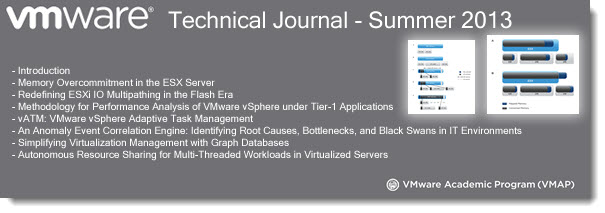Memory Overcommitment in The ESX server is just one of the chapters present in VMware Technical Journal, which went out few days ago. You'll find the information about how memory overcommit works and which techniques are used, and also some best practices or how to avoid pitfalls. It's a deep dive chapter. There are also some good diagrams showing how the memory
One thing that I've heard for a first time was a word “undercommitment”. It's actually simple fact that when for example you configure 5 VMs with 4 GB each on a host that has 32Gb in total. Then the host is undercommited.
What's rather cool is that the chapter or the experimentation (there are few in this chapter) was done on development build of ESX 6.0!
One of the experiments was using an SSD as a server caching, so there has been a 40 Gb SSD attached to the server. This SSD was used for swapping out memory pages when other memory reclamations techniques were already used. The results shows about twice as less latency when swapping occurring to SSD rather than to a spinning magnetic disks.
The VMware Technical Journal can be downloaded as a PDF or you can read the individual chapters online, as web pages. Below you can find the chapters on the 2013 Summer release.
- Introduction
- Memory Overcommitment in the ESX Server
- Redefining ESXi IO Multipathing in the Flash Era
- Methodology for Performance Analysis of VMware vSphere under Tier-1 Applications
- vATM: VMware vSphere Adaptive Task Management
- An Anomaly Event Correlation Engine: Identifying Root Causes, Bottlenecks, and Black Swans in IT Environments
- Simplifying Virtualization Management with Graph Databases
- Autonomous Resource Sharing for Multi-Threaded Workloads in Virtualized Servers
I hope that you enjoyed your read. Feel free to subscribe to our RSS feed.
Source: VMware Labs

